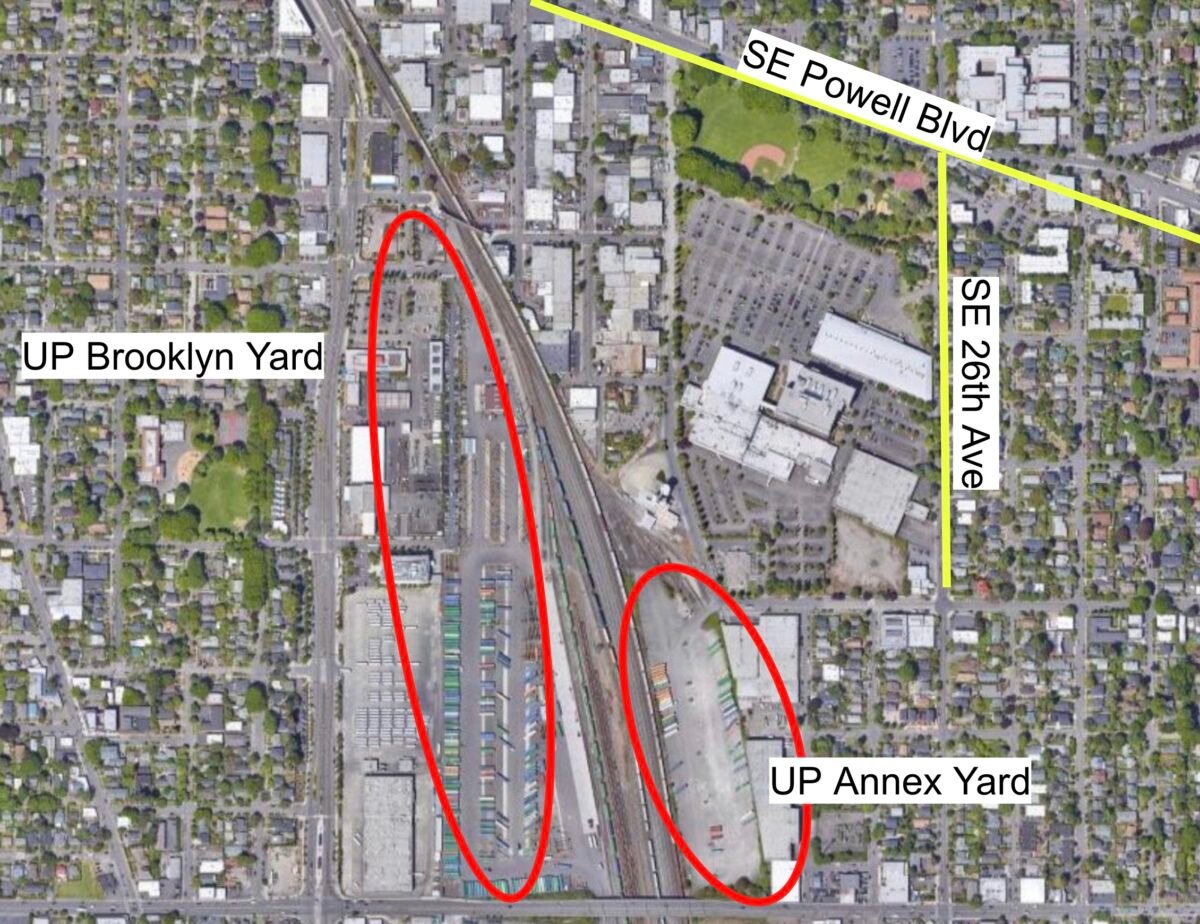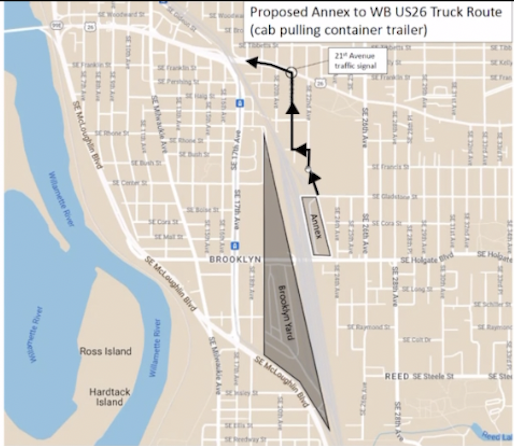 Railroad tracks separate the two yards. (Source: BikePortland)
Railroad tracks separate the two yards. (Source: BikePortland)
“If a truck driver’s doing ten trips a day, and the additional route causes them to [only] do nine trips a day, that’s a 10% cut in their pay.”
In the wake of an October crash that killed Portlander Sarah Pliner while she biked across Southeast Powell Blvd at 26th Avenue, advocates have pressed for changes. Pliner died after being hit by a man driving a semi-truck north on 26th Avenue as he made a sweeping right turn onto Powell and swiped her with the truck trailer in the process.
The tragedy spurred some safety advocates, freight industry experts and city transportation planners to reexamine truck traffic on 26th Ave. This street is located in an industrial area near both the Union Pacific Intermodal Rail Yard and the Fred Meyer distribution center, and drivers traveling to and from those locations are often toting massive trailers behind them that are difficult to control.
When we talked to people who work in the trucking industry in the immediate aftermath of the crash, some said it is inherently dangerous for semi-trucks to use the corridor, especially when they have to make a right turn onto Powell. With this in mind, the Portland Bureau of Transportation took some initial steps last month to discourage truck traffic from using this route.
At Thursday morning’s Portland Freight Committee (PFC) meeting, PBOT planner Zef Wagner provided new updates how the reroute would work. PBOT’s proposal sparked concerns from some members of the committee who worry that it requires too much out-of-direction travel for truck drivers.
 Proposed McLoughlin route change.
Proposed McLoughlin route change. From the annex to the truck route.(Source: PBOT)
From the annex to the truck route.(Source: PBOT)
“Union Pacific is open to reorganizing Brooklyn yards to consolidate operations, but right now…they just don’t have space.”
According to Wagner, recent PBOT analysis has found that the majority of problematic freight truck traffic on 26th comes from the Union Pacific rail yard. (Truck deliveries to the Fred Meyer distribution center are evidently less common and involve smaller trucks.) Truck drivers meet up with freight trains at the rail yard in the Brooklyn neighborhood and ferry goods back and forth to the Union Pacific Annex for storage.
The main rail yard and annex are just across the train tracks from each other, accessible by car via Holgate Blvd, 26th Ave and Gladstone St. This is just a short distance, but it’s right through very narrow residential streets. PBOT’s suggestion is to trade off the short drive for one that relies more on large arterials, not on local neighborhood streets where people live, walk and bike.
“We looked at it, and we think we have found a better route — even though it’s a little bit out of direction,” Wagner said to the committee.
He said a more appropriate route would be to take McLoughlin westbound until it links up with Powell, where there’s a sizable swooping ramp to make the right turn easier for trucks hauling huge trailers. When trucks leave the annex to carry goods to their end destinations via the US 26 truck route, they can take 21st Ave to get onto Powell (see maps above).
What do truck advocates think?
 (Photo: Jonathan Maus/BikePortland)
(Photo: Jonathan Maus/BikePortland)
To say the McLoughlin reroute is a “little bit out of direction” is an understatement — it turns a two or three minute drive into a 10 or 15 minute one, depending on the traffic situation on McLoughlin and Powell. But PBOT’s view is that local residential streets were never intended to be used by large freight trucks, and it makes sense to want to send the trucks to the highways, even if they’re out of the way.
Members of the PFC were cautious and warned that truck drivers and freight companies may not agree.
PFC member Corky Collier said if a truck driver’s productivity decreases because of the added drive time, they’ll lose out on pay.
“If a truck driver’s doing ten trips a day, and the additional route causes them to [only] do nine trips a day, that’s a 10% cut in their pay,” Collier said. He added that increased driving times could hamper Portland’s emissions reductions goals, and he doesn’t want the freight industry to be blamed for it.
“The emissions start adding up pretty significantly,” Collier said. “You may still want to do it. But if that’s the case, PBOT should be saying, ‘this increase in greenhouse gas emissions is our fault.'”
Wagner said even though the trucks were previously only moving a short distance, they were stopping and starting often and causing congestion in the neighborhoods — meaning there may or may not be a significant increase in greenhouse gas emissions. And the detour would only apply to outbound trips: once the trucks drop off their trailers, it’s not nearly as intrusive for drivers to just take the cabs back through the residential route.
Containing the problem
 A lot of containers at Brooklyn Yard. (Photo: Union Pacific)
A lot of containers at Brooklyn Yard. (Photo: Union Pacific)
But the real problem here goes deeper. The reason Union Pacific freight goods have to be moved back and forth between the annex and the main rail yard so much is because of abnormally high container traffic. Ideally, they’d be able to consolidate operations onto one side of the track, but the quantity of goods is too large right now for that to be possible.
“Union Pacific is open to reorganizing their Brooklyn yards to try to consolidate operations, but right now they have such high container traffic that they just don’t have space for all the containers,” Wagner said.
This is the same reason for the clogged up railroad tracks that have caused so much grief for people traveling around southeast Portland lately. The situation has become so problematic that PBOT is seeking federal funding to find solutions.
Wagner said PBOT will continue to do analysis in the coming months. If they decide to take this approach, it’s unclear how strongly the city would be able to enforce it. Wagner said he wants to put up wayfinding signs discouraging truck drivers to travel on 26th between Gladstone and Powell — but will a sign really be enough to get drivers to take this detour?
This discussion was also yet another indication of just how deep SE Powell Blvd’s safety problems run, and how many different players are involved. It’s going to take a coordinated effort from bike and safety advocates, freight industry reps, and local transportation agencies in order to make change. In the meantime, 26th Ave and similar streets in the neighborhoods surrounding the rail yards — which happen to be home to many families with kids and lots of people who rely on biking and walking to get around — will be unreasonably dangerous.

Taylor has been BikePortland’s staff writer since November 2021. She has also written for Street Roots and Eugene Weekly. Contact her at This email address is being protected from spambots. You need JavaScript enabled to view it.

